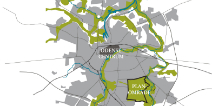|
Task Force for Climate Change Adaptation
In November 2011 the Danish government decided to relocate the
Information Centre for Climate Change Adaptation from the Ministry
of Climate and Energy to the Ministry of the Environment. In the
Ministry of the Environment the information centre is now
incorporated in a new The Task Force for Climate Change
Adaptation.
The Minister of the Environment, Ida Auken, has announced that
every municipality in Denmark should have an action plan for
climate change adaptation ready before the end of 2013. A Climate
Change Adaptation Squad was established in February 2012 in order
to secure that every municipality has the necessary guidance to
produce the action plan. The squad will visit municipalities on
demand.
The Resilient House
A new tool, The Resilient House, has been launched at
klimatilpasning.dk. The tool provides the user with an interactive
experience of different risk and adaptation potential around a
virtual house. The purpose of the tool is to provide house
owners with information about what they can do to prevent
flooding in and around their house to make them more aware of the
potential climate change risks at home in short as well as long
term.
Cases of climate change adaptation in Denmark
In the second largest city, Aarhus, a wetland is adapted
into a new lake that collects excess rain water to prevent
flooding. Furthermore the lake reduces nitrogen leaching from
surrounding agricultural land.
The historic amusement park, Tivoli, in Copenhagen city centre,
experienced great devastation from the extreme rainfall in July
2011. Thus an emergency response plan has been made along with
essential readjustment in the park to decrease its
vulnerability.
In the fairytale writer H.C. Andersen's hometown and the third
largest city in Denmark, Odense, climate change
adaptation will be taken into account while building the
new Odense University Hospital. Measures will be taken to
ensure that the hospital grounds are able to handle excessive
rainfall without contributing to flooding elsewhere.
CLIWAT
The CLIWAT (Climate Change and Ground Water) project was ended in
March 2012 and the results of the project highlight climate change
impacts on groundwater resources. The project involving 16 partners
from Belgium, Holland, Germany and Denmark was funded by the EU
development fund Interreg IVB and led to the publications of a
new book entitled "Ground Water in a Future Climate" describing the
project, that was published in December 2011.
|





